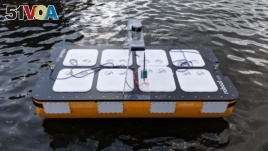28 October 2020
The development and testing of self-driving car technology has seen major progress in recent years. But engineers are working on other kinds of autonomous vehicles too -- including some built for water.
Researchers at the Massachusetts Institute of Technology, MIT, are leading one such project. The engineers have been developing autonomous water vehicles they call "roboats." The word is a combination of "robot" and "boat."
The project – which began in 2016 – aims to create a group of boats to transport goods and people along the waterways of Amsterdam. The Dutch capital has been called the world's "most watery city" because of its large network of canals.

This photograph shows the latest version of MIT's autonomous boat - Roboat II, which is two meters long and is capable of carrying passengers. (Photo: MIT/CSAIL researchers)
The project was launched in an effort to explore how autonomous boats can make Amsterdam - and other cities - more efficient and improve the population's quality of life.
MIT's Artificial Intelligence Laboratory, CSAIL, is leading the development in a partnership with the university's Senseable City Lab.
The engineers centered past efforts on autonomous boats designed to transport small goods. But the project's latest creation, the Roboat II, can also carry passengers.
The developers used machine-learning methods similar to those used to train self-driving cars. The robotic boats are designed to not only carry people and goods, but also "connect with other Roboats to form a range of autonomous platforms," Daniela Rus said in a statement. She is a professor at MIT and the director of CSAIL.
The electric-powered Roboat II has four propellers that permit it to move in any direction. It is equipped with a series of cameras and sensors to guide its movements. It also uses LiDAR, a technology that uses light lasers to map the environment and measure distances.
The boats are designed to use the sensor-collected data to create and "pilot a path between a series of goal points," the researchers say.
The Roboat II measures two meters by one meter and weighs about 80 kilograms. A demonstration video of the model showed it carrying two passengers.
The MIT team is currently developing its third autonomous water vehicle. That boat is expected to be four meters long and is designed to carry up to six passengers.
The researchers described their latest development and testing results in a paper published online. They said Roboat II was successful in autonomously navigating the canals of Amsterdam for three hours while collecting data. The boat completed its chosen course and returned to the starting point with an error of just 0.17 meters, engineers reported.
The team says it designed its autonomous system to involve separate boats working together. For example, Roboat II vehicles can link up in larger groups guided by a leader boat, the researchers say. The follower boats can travel next to the leader boat, in front of it or in back of it. This ability can greatly expand the possibilities of autonomous vehicles meant to transport goods.
The MIT team plans to use what it has learned from its first two Roboats to create a model of its biggest autonomous boat yet. The researchers will test that boat in Amsterdam, as well. After that, the team plans to start testing the vehicles in environments with "more noisy waters," such as conditions found in the ocean.
There have already been some experiments with autonomous shipping vehicles. In September, it was announced that an ocean research vehicle called the Mayflower Autonomous Ship would attempt to set sail across the Atlantic without a captain or crew on board.
The 15-meter ship is a joint project of ocean research group ProMare and IBM, the American computing company. It will take the same path across the Atlantic as the 1620 Mayflower - the ship that carried a group of European settlers to North America. The crossing is planned to begin early next year.
The builders of the new Mayflower say they hope such ships can be used in the future to explore parts of oceans that are too difficult or dangerous for people to reach.
I'm Bryan Lynn.
Bryan Lynn wrote this story based on reports from MIT. Ashley Thompson was the editor.
We want to hear from you. Write to us in the Comments Section, and visit 51VOA.COM.
____
Words in This Story
autonomous – adj. independent and having the power to operate automatically without human involvement
canal – n. an artificial river built for boats to travel along or to take water where it is needed
efficient – adj. working well and not wasting time or energy
range – n. a group of different things of the same general kind
platform – n. a vehicle used for a particular purpose or to carry a specified kind of equipment
propeller – n. piece of equipment made of two or more flat metal pieces that turn around and cause a ship or aircraft to move
navigate – v. to determine the correct sea or land route
captain – n. the person in control of a ship or aircraft
error – n. a mistake












